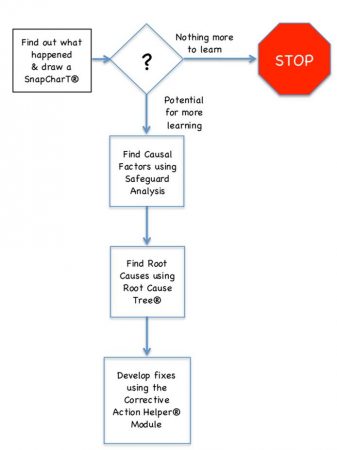Simple Root Cause Analysis (Don’t Settle!)

How many companies are using TapRooT® for their “hard,” “high-risk” incident analyses and using something like 5-Whys for the “simple” stuff? Yep, I thought so. A lot of companies are doing this for various reasons. I’ll get into that more in a minute.
Now, another poll:
How many of you are performing effective root cause analyses on your “important,” “high-consequence” investigations, and performing nearly useless analyses on the “easy” stuff? Of course, you know this is really exactly the same question, but you’re not as comfortable raising your hand the second time, are you?
Those of you that follow this blog have already read why using inferior RCA methods don’t work well, but let me recap. I’m going to talk about 5-Whys specifically, but you can probably insert any of your other, less-robust analysis techniques here:
5-Whys
- It does not use an expert system. It relies on the investigator to know what questions to ask.
- Because of this, it allows for investigator bias. If you are a training person, you will (amazingly enough) end up with “training” root causes.
- The process does not rely on human performance expertise. Again, it relies on the skill of the investigator. Yes, I know, we’re all EXCELLENT investigators!
- It does not produce consistent results. If I give the same investigation to 3 different teams, I always get 3 different sets of answers.
- There is no assistance in developing effective corrective action. When 80% of your corrective actions fall into the “Training” “Procedures” and “Discipline” categories, you are not really expecting any new results, are you?
So, knowing this to be true, why are we doing this? Why are we allowing ourselves to knowingly get poor results?
- These are low risk problems, anyway. It doesn’t matter if we get good answers (Why bother, then?)
- It’s quick. (Of course, quickly getting poor results just doesn’t seem to be an effective use of your time.)
- It’s easy (to get poor results).
- TapRooT® takes too long. Finally, an answer that, while not true, at least makes sense.
So what you’re really telling me is that if TapRooT® were just easier to use, you would be able to ditch those other less robust methods, and use TapRooT® for the “easy” stuff, too.
Guess what? We’ve now made TapRooT® even easier to use! The 7-step TapRooT® process can now be shortened for those “easy” investigations, and still get the excellent results you’re used to getting.
 We now teach the normal 7-Step method for major incidents, where you need the optional data-collection tools. However, we are now showing you how to use TapRooT® in low to medium-risk investigations. You are still using the tools that make TapRooT® a great root cause analysis tool. However, we show you how to shorten the time it takes to perform these less-complex analyses.
We now teach the normal 7-Step method for major incidents, where you need the optional data-collection tools. However, we are now showing you how to use TapRooT® in low to medium-risk investigations. You are still using the tools that make TapRooT® a great root cause analysis tool. However, we show you how to shorten the time it takes to perform these less-complex analyses.
The 2-Day TapRooT® Incident Investigation Course concentrates on these low to medium-risk investigations. The 5-Day TapRooT® Advanced Team Leader Course teaches both the simple method, but also teaches the full suite of TapRooT® tools.
Don’t settle for poor investigations, knowing the results are not what you need. Take a look at the new TapRooT® courses and see how to use the system for all of your investigations. You can register for one of these courses here.



